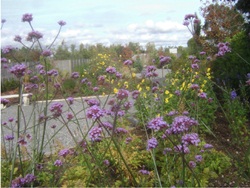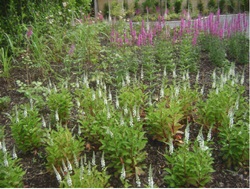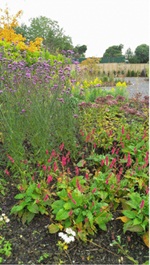
Purple band of Panicum running through middle of border at Kew Gardens
All forms of gardening are impositions on nature to a lesser or greater degree. They require a fair bit of effort and know how, to be done properly. The most ‘natural’ looking garden is not absolved from this requirement. The Japanese, who make the most stunning and naturalistic gardens, are well aware of this. These sparse and minimalistic gardens are labour intensive to the nth degree, and just as important, great thought goes into everything that is done.
Prairie gardens are supposed to be closely planted, because in theory, close planting will crowd out the weeds, but that’s a forlorn hope in this country. For instance on heavy soil, creeping buttercup would have no trouble running riot through perennials if not taken in hand at an early stage. Wide closely planted borders are difficult to get into for weeding purposes. I visited a prairie border at Wisley in Surrey in the much drier south east of England, which would slow down weed growth considerably. A gardener there told me that they just weeded the easy to get at front of border in summer, and gave the rest of it a good going over in winter. I have a feeling that by that stage, in Ireland, the weeds would be out of control.
I was not overly impressed with this border, (though very impressed by lots of their other borders) which was designed by Piet Oudolf, and put in a few years ago. It was not very exciting, you could walk past without noticing it, and this was in September, when the prairie border is at its peak. The problem with very naturalistic planting schemes, is that without careful management, they become formless and untidy – some might say they are half way there to start with!. Still, prairie planting at its best is amazing, but it is high end gardening, not plant and walk away. A good rule of thumb in gardening is, that the bigger and woodier the plants used, the less maintenance required. So herbaceous perennials will generally require more maintenance than shrubs and trees.
There is a very good book just out on the subject by the same Piet Oudolf. It’s called ‘Landscapes in Landscapes’ (I don’t really know what that means)and the pictures alone are amazing. It charts many of his commissions both public and private, and includes one, believe it or not, done in Kerry, not exactly prime prairie country! I wonder what that garden looks like today. There are good plant lists included. In our prairie border we planted not so close together, in order to make weeding easier. We mulched with very un-prairie like tree bark for the same reason.
Below are some does and don’ts of prairie planting:
- Plants that need staking are out, as are those that need deadheading. The dead flower heads are regarded as a decorative feature, thus making a virtue of necessity.
- Plants that run a lot at the root, such as Lysimachia punctata are out, as they would be difficult to control.
- Plants with excessively showy flowers or bright variegated foliage are not used as they can look out of place, and spoil the more muted natural look.
- Prairie gardens come into their own in late summer to Autumn, though provision is often made for some earlier flowerers.
- The border aspect should be in full sun, as much as possible.
I found that some popular prairie plants just do not perform for us, due to our cool summers. Echinaceas, which are such iconic prairie plants, with their stylish daisy flowers are always a disappointment with me.

Purple band of Panicum running through middle of border at Kew Gardens
Two very decorative ornamental grasses Panicum and Pennisetum also disappoint in this country. When I was in Kew Gardens last year, the Panicums in their grass border were absolutely stunning – that’s the advantage for being that bit further south and east.
Below are some plants that have done well in their first year, on our heavy Co. Meath soil:
- Eupatorium maculatum ‘Atropurpureum’ and varieties: Perhaps the number 1 prairie plant.
- Actea simplex: Tall, self supporting and elegant.
- Helianthus ‘Morgensonne’, Helianthus ‘Lemon Queen’, Helianthus’ Capenoch Star’: All these perennial sun flowers should be much more widely grown.

Verbena bonariensis with Helianthus Morgensonne in Ratoath Garden Centre prairie border.
- Lythrum salicaria varieties: Native plants, great in drifts, fade well.
- Lysimachia clethroides: Good, long lasting, slightly invasive.

- Solidago ‘Goldenmosa’: good impact and contrast to other plants, and a ppp (proper prairie plant).
- Sanguisorba obtusa, S. tenuifolia ‘Pink Elephant’, S. menziesii: Sanguisorbas work well in prairie plantings with their very informal flowers and habit.
- Miscanthus and Molinia grasses: Easiest and most reliable grasses for Irish soils and climate, with lots of size variation.
- Verbena bonariensis: Very popular, don’t allow them get to tall. They repay a little judicious pruning when in full flower.
- Rudbeckia ‘Goldsturm’, Rudbeckia ‘Little Gold Star’: Always perform.
- Aster f. ‘Monch’: long flowering for front of border.
- Aster ‘Little Carlow’: small flowers with good colour.
- Aconitum Carmichael: good late flowerer, not a normal choice for a prairie border.
- Veronicastrum virginium ‘Album’: very elegant, with horizontal foliage contrasting with vertical flower heads
- Persicaria ampexicaulis ‘Fire tail’, Persicaria am. Alba: class plants, with cast iron constitutions

Persicaria ampexicaulis ‘Fire tail’ with Verbena, Solidago and dwarf eupatorium in our new prairie border
- Filipendula palmata, pink and red forms: Vigorous leafy plants, would be good in general landscaping.
- Aruncus dioicus: Like large creamy astilbe, good mixer.
- Astilbe chinensis ‘Pumila’ and ‘Superba’: better garden plants than Japonica types
- Trifolium ochroleucum: like a giant white clover, everyone comments on this plant!
- Coreopsis v. ‘Zagreb’: tough front of border daisy, that belies its delicate appearance.
- Stachys officinalis ‘Rosea’: needs to be planted in large groups for effect.
Tall perennials are difficult to sell in garden centres, as they present poorly in pots and rarely show their full potential, hence the great difficulty of sourcing some of the above plants. The only way around this is to plant them in show borders, so the public can see them as they should be.
“John has a diploma in Horticulture from the National Botanic Gardens, a degree in Botany from Trinity College and a diploma in Tree Craftsmanship from Merrist Wood College in Surrey. He worked in the nurseries of north Germany where he got his interest in craft gardening. He is the owner of Ratoath Garden Centre, whose slogan “mad about plants”, is not far from the truth!”
Source: Hortitrends News Room




